Techniques to Reduce Radiation Dose During Neonatal Chest X-Rays
VerifiedAdded on 2023/06/11
|7
|2006
|152
Report
AI Summary
This report investigates methods to reduce radiation dose in neonatal chest x-ray procedures, addressing the increasing use of radiographic imaging and the particular sensitivity of children to ionizing radiation. It details the imaging equipment used, including the Konica Minolta CS-7 DR system and the RaySafe X2 dosimeter for measuring Entrance Surface Dose (ESD). The methodology includes a pilot study, exposure techniques, and patient dose measurement, emphasizing the importance of optimizing image quality while minimizing radiation exposure. Image quality evaluation was performed using relative visual grading analysis (VGA) by radiographer observers, and statistical analysis was conducted to assess the significance of ESD and image quality. The aim is to provide strategies for healthcare professionals to ensure safer chest x-ray practices for neonatal patients, considering factors like tube current, exposure duration, and examination techniques.
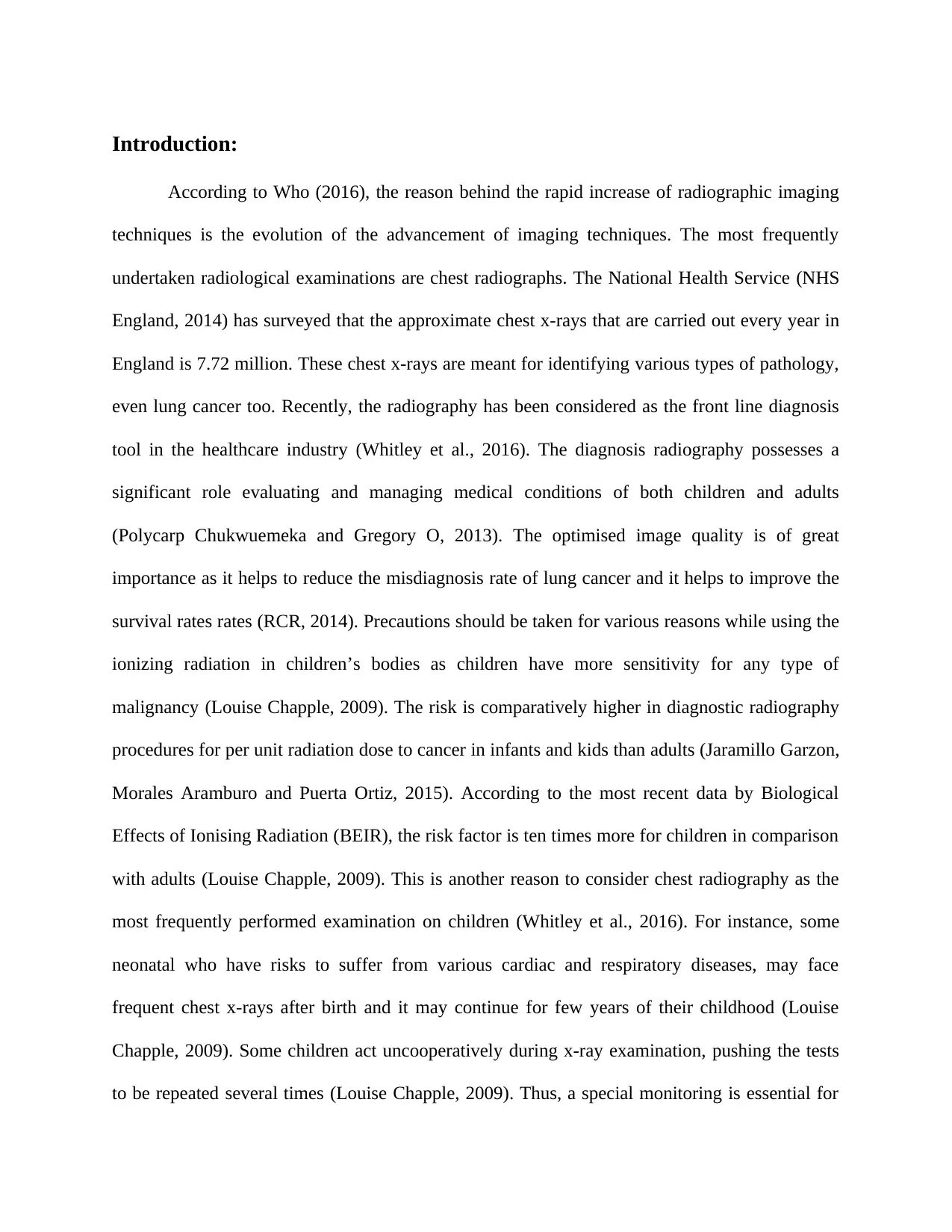
Introduction:
According to Who (2016), the reason behind the rapid increase of radiographic imaging
techniques is the evolution of the advancement of imaging techniques. The most frequently
undertaken radiological examinations are chest radiographs. The National Health Service (NHS
England, 2014) has surveyed that the approximate chest x-rays that are carried out every year in
England is 7.72 million. These chest x-rays are meant for identifying various types of pathology,
even lung cancer too. Recently, the radiography has been considered as the front line diagnosis
tool in the healthcare industry (Whitley et al., 2016). The diagnosis radiography possesses a
significant role evaluating and managing medical conditions of both children and adults
(Polycarp Chukwuemeka and Gregory O, 2013). The optimised image quality is of great
importance as it helps to reduce the misdiagnosis rate of lung cancer and it helps to improve the
survival rates rates (RCR, 2014). Precautions should be taken for various reasons while using the
ionizing radiation in children’s bodies as children have more sensitivity for any type of
malignancy (Louise Chapple, 2009). The risk is comparatively higher in diagnostic radiography
procedures for per unit radiation dose to cancer in infants and kids than adults (Jaramillo Garzon,
Morales Aramburo and Puerta Ortiz, 2015). According to the most recent data by Biological
Effects of Ionising Radiation (BEIR), the risk factor is ten times more for children in comparison
with adults (Louise Chapple, 2009). This is another reason to consider chest radiography as the
most frequently performed examination on children (Whitley et al., 2016). For instance, some
neonatal who have risks to suffer from various cardiac and respiratory diseases, may face
frequent chest x-rays after birth and it may continue for few years of their childhood (Louise
Chapple, 2009). Some children act uncooperatively during x-ray examination, pushing the tests
to be repeated several times (Louise Chapple, 2009). Thus, a special monitoring is essential for
According to Who (2016), the reason behind the rapid increase of radiographic imaging
techniques is the evolution of the advancement of imaging techniques. The most frequently
undertaken radiological examinations are chest radiographs. The National Health Service (NHS
England, 2014) has surveyed that the approximate chest x-rays that are carried out every year in
England is 7.72 million. These chest x-rays are meant for identifying various types of pathology,
even lung cancer too. Recently, the radiography has been considered as the front line diagnosis
tool in the healthcare industry (Whitley et al., 2016). The diagnosis radiography possesses a
significant role evaluating and managing medical conditions of both children and adults
(Polycarp Chukwuemeka and Gregory O, 2013). The optimised image quality is of great
importance as it helps to reduce the misdiagnosis rate of lung cancer and it helps to improve the
survival rates rates (RCR, 2014). Precautions should be taken for various reasons while using the
ionizing radiation in children’s bodies as children have more sensitivity for any type of
malignancy (Louise Chapple, 2009). The risk is comparatively higher in diagnostic radiography
procedures for per unit radiation dose to cancer in infants and kids than adults (Jaramillo Garzon,
Morales Aramburo and Puerta Ortiz, 2015). According to the most recent data by Biological
Effects of Ionising Radiation (BEIR), the risk factor is ten times more for children in comparison
with adults (Louise Chapple, 2009). This is another reason to consider chest radiography as the
most frequently performed examination on children (Whitley et al., 2016). For instance, some
neonatal who have risks to suffer from various cardiac and respiratory diseases, may face
frequent chest x-rays after birth and it may continue for few years of their childhood (Louise
Chapple, 2009). Some children act uncooperatively during x-ray examination, pushing the tests
to be repeated several times (Louise Chapple, 2009). Thus, a special monitoring is essential for
Paraphrase This Document
Need a fresh take? Get an instant paraphrase of this document with our AI Paraphraser
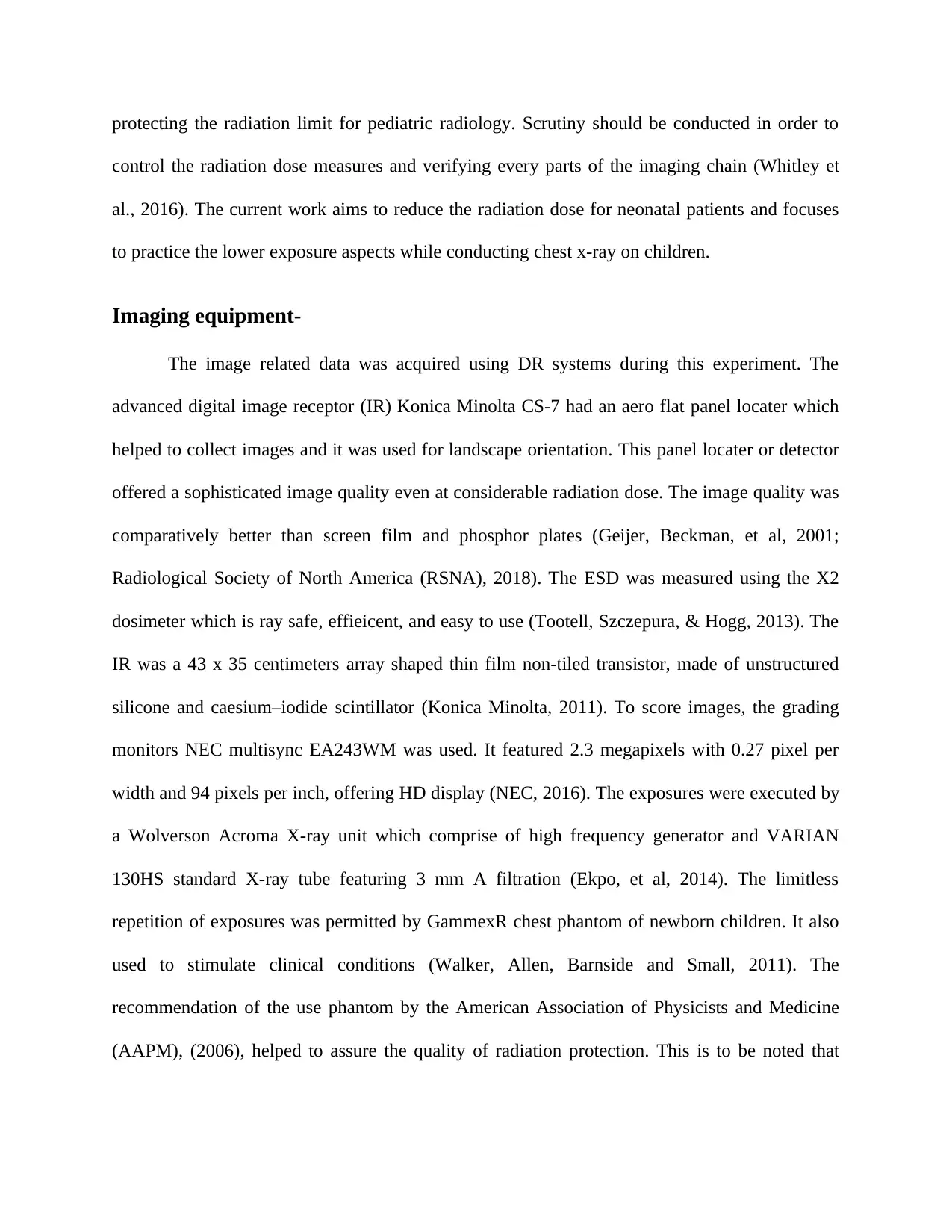
protecting the radiation limit for pediatric radiology. Scrutiny should be conducted in order to
control the radiation dose measures and verifying every parts of the imaging chain (Whitley et
al., 2016). The current work aims to reduce the radiation dose for neonatal patients and focuses
to practice the lower exposure aspects while conducting chest x-ray on children.
Imaging equipment-
The image related data was acquired using DR systems during this experiment. The
advanced digital image receptor (IR) Konica Minolta CS-7 had an aero flat panel locater which
helped to collect images and it was used for landscape orientation. This panel locater or detector
offered a sophisticated image quality even at considerable radiation dose. The image quality was
comparatively better than screen film and phosphor plates (Geijer, Beckman, et al, 2001;
Radiological Society of North America (RSNA), 2018). The ESD was measured using the X2
dosimeter which is ray safe, effieicent, and easy to use (Tootell, Szczepura, & Hogg, 2013). The
IR was a 43 x 35 centimeters array shaped thin film non-tiled transistor, made of unstructured
silicone and caesium–iodide scintillator (Konica Minolta, 2011). To score images, the grading
monitors NEC multisync EA243WM was used. It featured 2.3 megapixels with 0.27 pixel per
width and 94 pixels per inch, offering HD display (NEC, 2016). The exposures were executed by
a Wolverson Acroma X-ray unit which comprise of high frequency generator and VARIAN
130HS standard X-ray tube featuring 3 mm A filtration (Ekpo, et al, 2014). The limitless
repetition of exposures was permitted by GammexR chest phantom of newborn children. It also
used to stimulate clinical conditions (Walker, Allen, Barnside and Small, 2011). The
recommendation of the use phantom by the American Association of Physicists and Medicine
(AAPM), (2006), helped to assure the quality of radiation protection. This is to be noted that
control the radiation dose measures and verifying every parts of the imaging chain (Whitley et
al., 2016). The current work aims to reduce the radiation dose for neonatal patients and focuses
to practice the lower exposure aspects while conducting chest x-ray on children.
Imaging equipment-
The image related data was acquired using DR systems during this experiment. The
advanced digital image receptor (IR) Konica Minolta CS-7 had an aero flat panel locater which
helped to collect images and it was used for landscape orientation. This panel locater or detector
offered a sophisticated image quality even at considerable radiation dose. The image quality was
comparatively better than screen film and phosphor plates (Geijer, Beckman, et al, 2001;
Radiological Society of North America (RSNA), 2018). The ESD was measured using the X2
dosimeter which is ray safe, effieicent, and easy to use (Tootell, Szczepura, & Hogg, 2013). The
IR was a 43 x 35 centimeters array shaped thin film non-tiled transistor, made of unstructured
silicone and caesium–iodide scintillator (Konica Minolta, 2011). To score images, the grading
monitors NEC multisync EA243WM was used. It featured 2.3 megapixels with 0.27 pixel per
width and 94 pixels per inch, offering HD display (NEC, 2016). The exposures were executed by
a Wolverson Acroma X-ray unit which comprise of high frequency generator and VARIAN
130HS standard X-ray tube featuring 3 mm A filtration (Ekpo, et al, 2014). The limitless
repetition of exposures was permitted by GammexR chest phantom of newborn children. It also
used to stimulate clinical conditions (Walker, Allen, Barnside and Small, 2011). The
recommendation of the use phantom by the American Association of Physicists and Medicine
(AAPM), (2006), helped to assure the quality of radiation protection. This is to be noted that
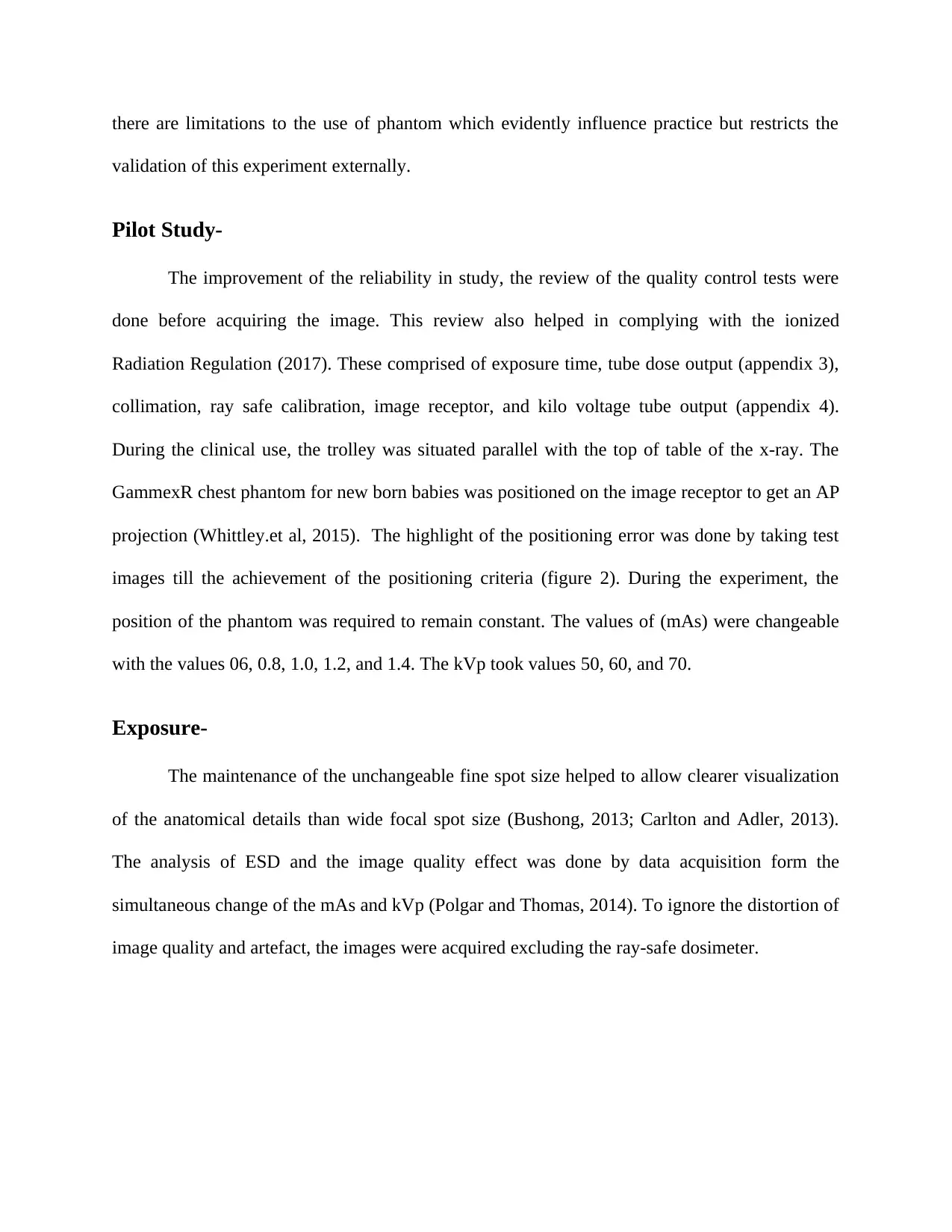
there are limitations to the use of phantom which evidently influence practice but restricts the
validation of this experiment externally.
Pilot Study-
The improvement of the reliability in study, the review of the quality control tests were
done before acquiring the image. This review also helped in complying with the ionized
Radiation Regulation (2017). These comprised of exposure time, tube dose output (appendix 3),
collimation, ray safe calibration, image receptor, and kilo voltage tube output (appendix 4).
During the clinical use, the trolley was situated parallel with the top of table of the x-ray. The
GammexR chest phantom for new born babies was positioned on the image receptor to get an AP
projection (Whittley.et al, 2015). The highlight of the positioning error was done by taking test
images till the achievement of the positioning criteria (figure 2). During the experiment, the
position of the phantom was required to remain constant. The values of (mAs) were changeable
with the values 06, 0.8, 1.0, 1.2, and 1.4. The kVp took values 50, 60, and 70.
Exposure-
The maintenance of the unchangeable fine spot size helped to allow clearer visualization
of the anatomical details than wide focal spot size (Bushong, 2013; Carlton and Adler, 2013).
The analysis of ESD and the image quality effect was done by data acquisition form the
simultaneous change of the mAs and kVp (Polgar and Thomas, 2014). To ignore the distortion of
image quality and artefact, the images were acquired excluding the ray-safe dosimeter.
validation of this experiment externally.
Pilot Study-
The improvement of the reliability in study, the review of the quality control tests were
done before acquiring the image. This review also helped in complying with the ionized
Radiation Regulation (2017). These comprised of exposure time, tube dose output (appendix 3),
collimation, ray safe calibration, image receptor, and kilo voltage tube output (appendix 4).
During the clinical use, the trolley was situated parallel with the top of table of the x-ray. The
GammexR chest phantom for new born babies was positioned on the image receptor to get an AP
projection (Whittley.et al, 2015). The highlight of the positioning error was done by taking test
images till the achievement of the positioning criteria (figure 2). During the experiment, the
position of the phantom was required to remain constant. The values of (mAs) were changeable
with the values 06, 0.8, 1.0, 1.2, and 1.4. The kVp took values 50, 60, and 70.
Exposure-
The maintenance of the unchangeable fine spot size helped to allow clearer visualization
of the anatomical details than wide focal spot size (Bushong, 2013; Carlton and Adler, 2013).
The analysis of ESD and the image quality effect was done by data acquisition form the
simultaneous change of the mAs and kVp (Polgar and Thomas, 2014). To ignore the distortion of
image quality and artefact, the images were acquired excluding the ray-safe dosimeter.
⊘ This is a preview!⊘
Do you want full access?
Subscribe today to unlock all pages.

Trusted by 1+ million students worldwide
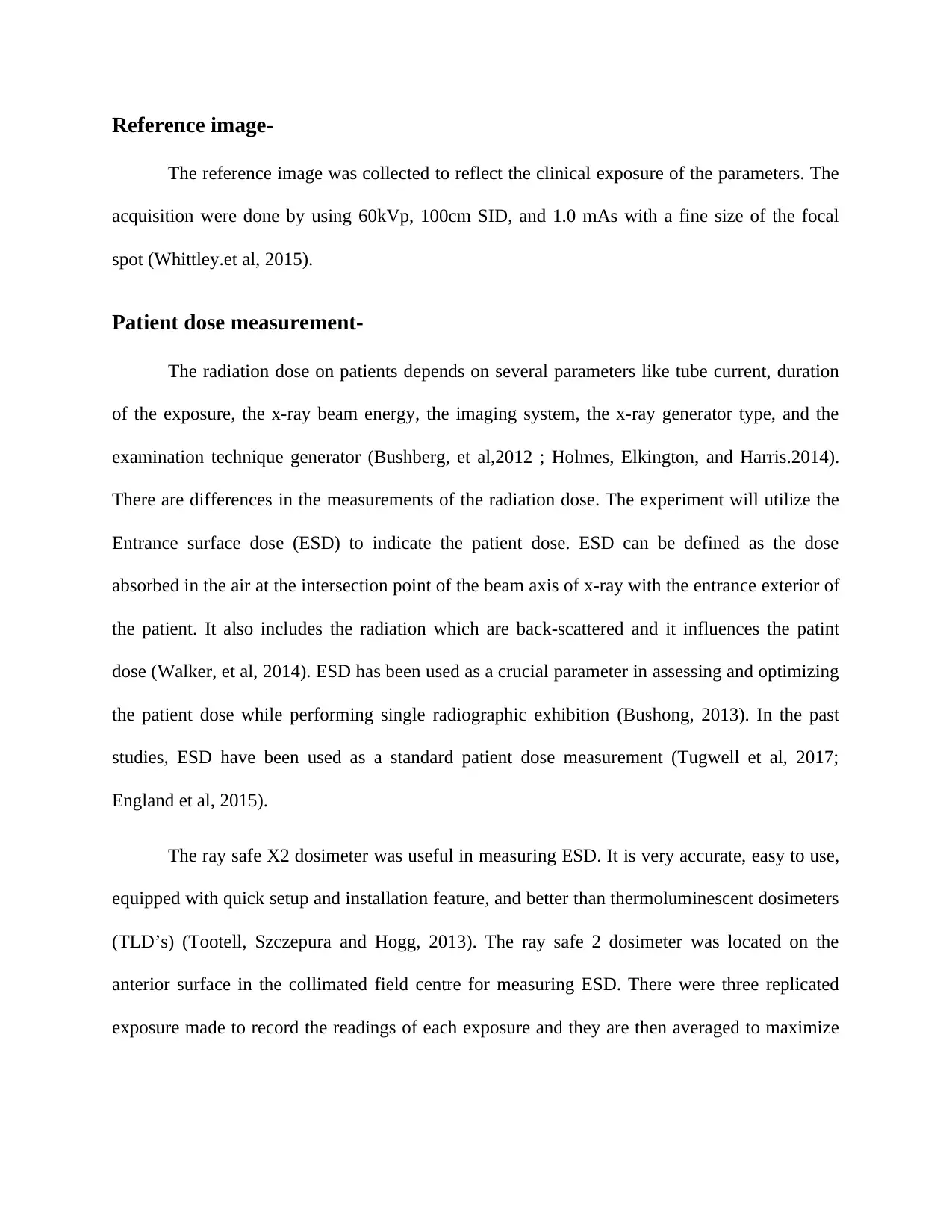
Reference image-
The reference image was collected to reflect the clinical exposure of the parameters. The
acquisition were done by using 60kVp, 100cm SID, and 1.0 mAs with a fine size of the focal
spot (Whittley.et al, 2015).
Patient dose measurement-
The radiation dose on patients depends on several parameters like tube current, duration
of the exposure, the x-ray beam energy, the imaging system, the x-ray generator type, and the
examination technique generator (Bushberg, et al,2012 ; Holmes, Elkington, and Harris.2014).
There are differences in the measurements of the radiation dose. The experiment will utilize the
Entrance surface dose (ESD) to indicate the patient dose. ESD can be defined as the dose
absorbed in the air at the intersection point of the beam axis of x-ray with the entrance exterior of
the patient. It also includes the radiation which are back-scattered and it influences the patint
dose (Walker, et al, 2014). ESD has been used as a crucial parameter in assessing and optimizing
the patient dose while performing single radiographic exhibition (Bushong, 2013). In the past
studies, ESD have been used as a standard patient dose measurement (Tugwell et al, 2017;
England et al, 2015).
The ray safe X2 dosimeter was useful in measuring ESD. It is very accurate, easy to use,
equipped with quick setup and installation feature, and better than thermoluminescent dosimeters
(TLD’s) (Tootell, Szczepura and Hogg, 2013). The ray safe 2 dosimeter was located on the
anterior surface in the collimated field centre for measuring ESD. There were three replicated
exposure made to record the readings of each exposure and they are then averaged to maximize
The reference image was collected to reflect the clinical exposure of the parameters. The
acquisition were done by using 60kVp, 100cm SID, and 1.0 mAs with a fine size of the focal
spot (Whittley.et al, 2015).
Patient dose measurement-
The radiation dose on patients depends on several parameters like tube current, duration
of the exposure, the x-ray beam energy, the imaging system, the x-ray generator type, and the
examination technique generator (Bushberg, et al,2012 ; Holmes, Elkington, and Harris.2014).
There are differences in the measurements of the radiation dose. The experiment will utilize the
Entrance surface dose (ESD) to indicate the patient dose. ESD can be defined as the dose
absorbed in the air at the intersection point of the beam axis of x-ray with the entrance exterior of
the patient. It also includes the radiation which are back-scattered and it influences the patint
dose (Walker, et al, 2014). ESD has been used as a crucial parameter in assessing and optimizing
the patient dose while performing single radiographic exhibition (Bushong, 2013). In the past
studies, ESD have been used as a standard patient dose measurement (Tugwell et al, 2017;
England et al, 2015).
The ray safe X2 dosimeter was useful in measuring ESD. It is very accurate, easy to use,
equipped with quick setup and installation feature, and better than thermoluminescent dosimeters
(TLD’s) (Tootell, Szczepura and Hogg, 2013). The ray safe 2 dosimeter was located on the
anterior surface in the collimated field centre for measuring ESD. There were three replicated
exposure made to record the readings of each exposure and they are then averaged to maximize
Paraphrase This Document
Need a fresh take? Get an instant paraphrase of this document with our AI Paraphraser
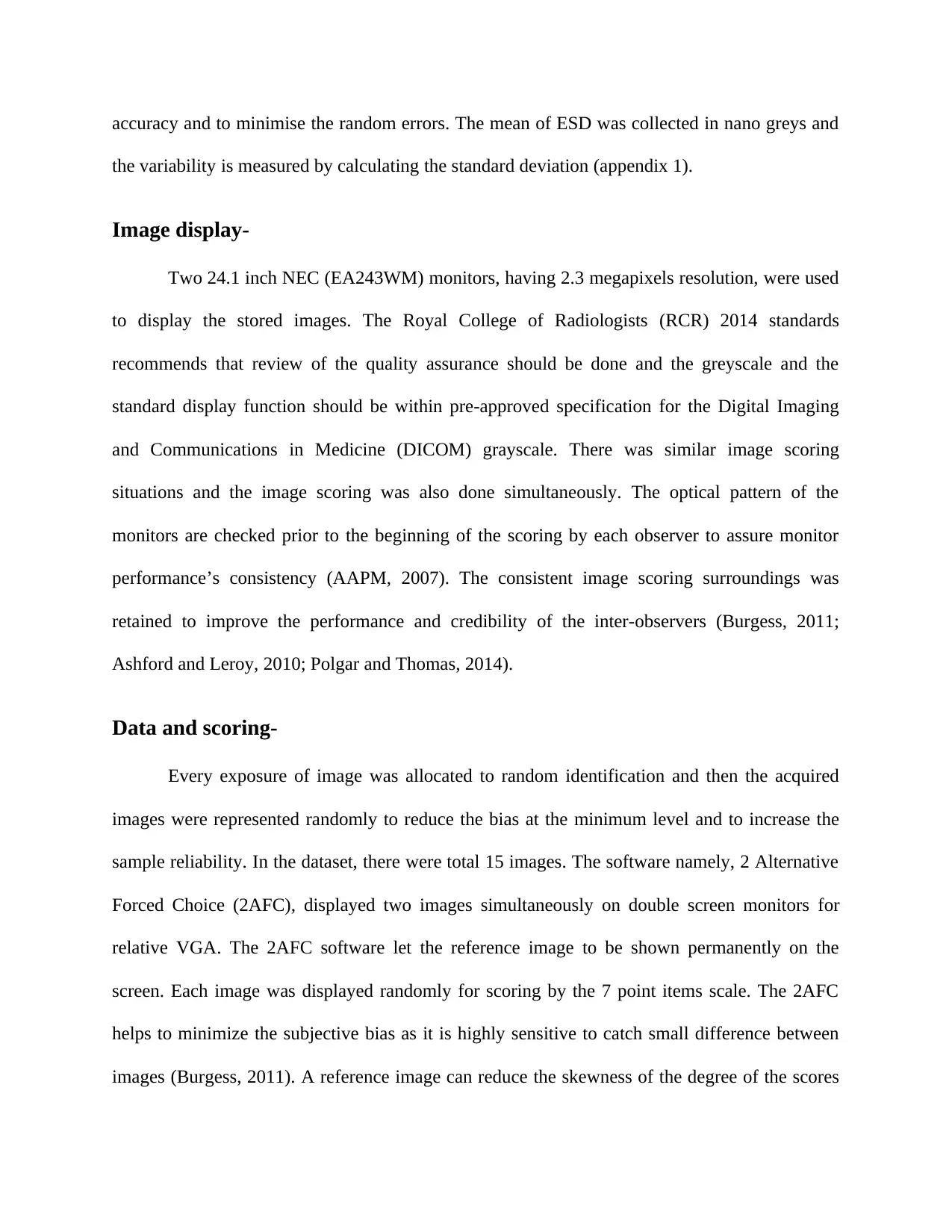
accuracy and to minimise the random errors. The mean of ESD was collected in nano greys and
the variability is measured by calculating the standard deviation (appendix 1).
Image display-
Two 24.1 inch NEC (EA243WM) monitors, having 2.3 megapixels resolution, were used
to display the stored images. The Royal College of Radiologists (RCR) 2014 standards
recommends that review of the quality assurance should be done and the greyscale and the
standard display function should be within pre-approved specification for the Digital Imaging
and Communications in Medicine (DICOM) grayscale. There was similar image scoring
situations and the image scoring was also done simultaneously. The optical pattern of the
monitors are checked prior to the beginning of the scoring by each observer to assure monitor
performance’s consistency (AAPM, 2007). The consistent image scoring surroundings was
retained to improve the performance and credibility of the inter-observers (Burgess, 2011;
Ashford and Leroy, 2010; Polgar and Thomas, 2014).
Data and scoring-
Every exposure of image was allocated to random identification and then the acquired
images were represented randomly to reduce the bias at the minimum level and to increase the
sample reliability. In the dataset, there were total 15 images. The software namely, 2 Alternative
Forced Choice (2AFC), displayed two images simultaneously on double screen monitors for
relative VGA. The 2AFC software let the reference image to be shown permanently on the
screen. Each image was displayed randomly for scoring by the 7 point items scale. The 2AFC
helps to minimize the subjective bias as it is highly sensitive to catch small difference between
images (Burgess, 2011). A reference image can reduce the skewness of the degree of the scores
the variability is measured by calculating the standard deviation (appendix 1).
Image display-
Two 24.1 inch NEC (EA243WM) monitors, having 2.3 megapixels resolution, were used
to display the stored images. The Royal College of Radiologists (RCR) 2014 standards
recommends that review of the quality assurance should be done and the greyscale and the
standard display function should be within pre-approved specification for the Digital Imaging
and Communications in Medicine (DICOM) grayscale. There was similar image scoring
situations and the image scoring was also done simultaneously. The optical pattern of the
monitors are checked prior to the beginning of the scoring by each observer to assure monitor
performance’s consistency (AAPM, 2007). The consistent image scoring surroundings was
retained to improve the performance and credibility of the inter-observers (Burgess, 2011;
Ashford and Leroy, 2010; Polgar and Thomas, 2014).
Data and scoring-
Every exposure of image was allocated to random identification and then the acquired
images were represented randomly to reduce the bias at the minimum level and to increase the
sample reliability. In the dataset, there were total 15 images. The software namely, 2 Alternative
Forced Choice (2AFC), displayed two images simultaneously on double screen monitors for
relative VGA. The 2AFC software let the reference image to be shown permanently on the
screen. Each image was displayed randomly for scoring by the 7 point items scale. The 2AFC
helps to minimize the subjective bias as it is highly sensitive to catch small difference between
images (Burgess, 2011). A reference image can reduce the skewness of the degree of the scores
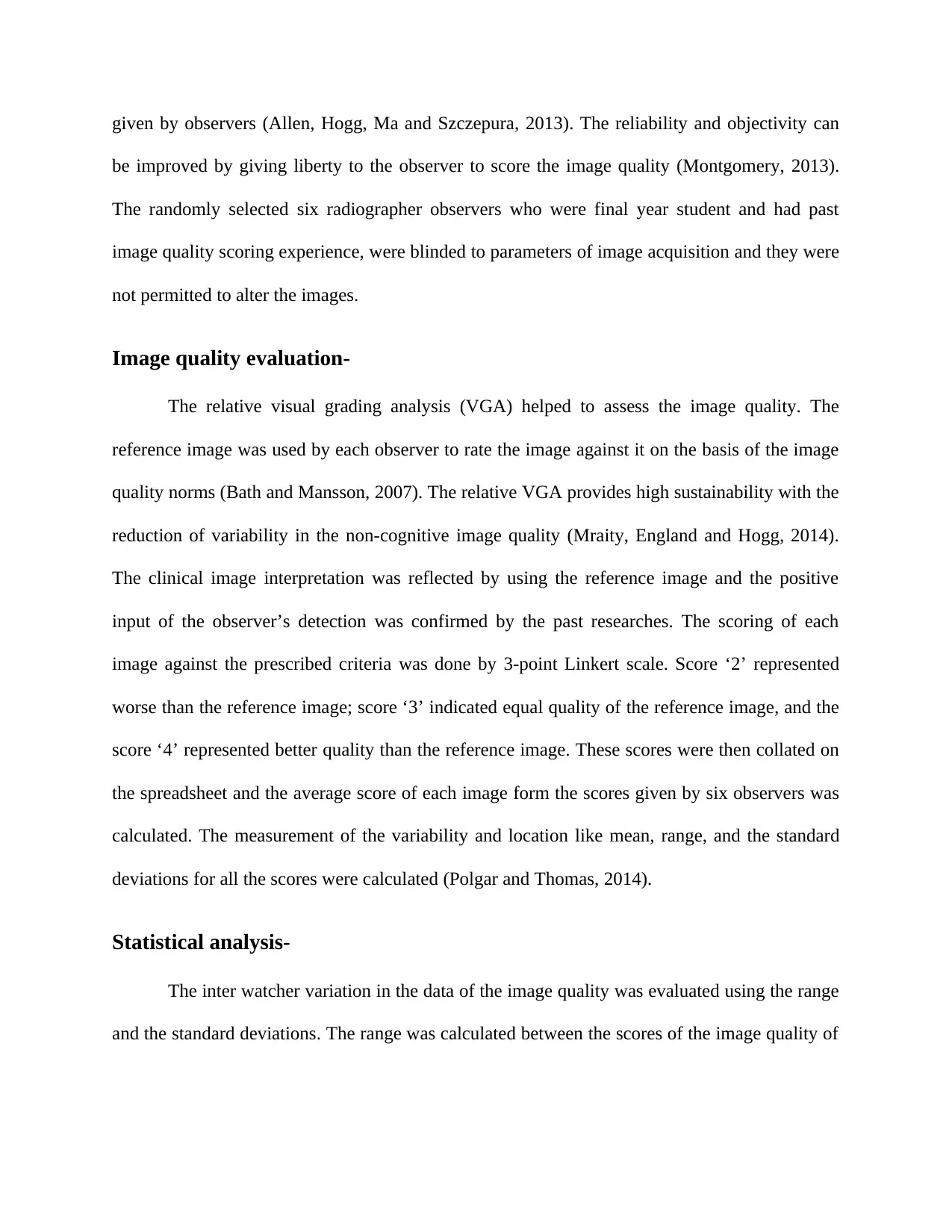
given by observers (Allen, Hogg, Ma and Szczepura, 2013). The reliability and objectivity can
be improved by giving liberty to the observer to score the image quality (Montgomery, 2013).
The randomly selected six radiographer observers who were final year student and had past
image quality scoring experience, were blinded to parameters of image acquisition and they were
not permitted to alter the images.
Image quality evaluation-
The relative visual grading analysis (VGA) helped to assess the image quality. The
reference image was used by each observer to rate the image against it on the basis of the image
quality norms (Bath and Mansson, 2007). The relative VGA provides high sustainability with the
reduction of variability in the non-cognitive image quality (Mraity, England and Hogg, 2014).
The clinical image interpretation was reflected by using the reference image and the positive
input of the observer’s detection was confirmed by the past researches. The scoring of each
image against the prescribed criteria was done by 3-point Linkert scale. Score ‘2’ represented
worse than the reference image; score ‘3’ indicated equal quality of the reference image, and the
score ‘4’ represented better quality than the reference image. These scores were then collated on
the spreadsheet and the average score of each image form the scores given by six observers was
calculated. The measurement of the variability and location like mean, range, and the standard
deviations for all the scores were calculated (Polgar and Thomas, 2014).
Statistical analysis-
The inter watcher variation in the data of the image quality was evaluated using the range
and the standard deviations. The range was calculated between the scores of the image quality of
be improved by giving liberty to the observer to score the image quality (Montgomery, 2013).
The randomly selected six radiographer observers who were final year student and had past
image quality scoring experience, were blinded to parameters of image acquisition and they were
not permitted to alter the images.
Image quality evaluation-
The relative visual grading analysis (VGA) helped to assess the image quality. The
reference image was used by each observer to rate the image against it on the basis of the image
quality norms (Bath and Mansson, 2007). The relative VGA provides high sustainability with the
reduction of variability in the non-cognitive image quality (Mraity, England and Hogg, 2014).
The clinical image interpretation was reflected by using the reference image and the positive
input of the observer’s detection was confirmed by the past researches. The scoring of each
image against the prescribed criteria was done by 3-point Linkert scale. Score ‘2’ represented
worse than the reference image; score ‘3’ indicated equal quality of the reference image, and the
score ‘4’ represented better quality than the reference image. These scores were then collated on
the spreadsheet and the average score of each image form the scores given by six observers was
calculated. The measurement of the variability and location like mean, range, and the standard
deviations for all the scores were calculated (Polgar and Thomas, 2014).
Statistical analysis-
The inter watcher variation in the data of the image quality was evaluated using the range
and the standard deviations. The range was calculated between the scores of the image quality of
⊘ This is a preview!⊘
Do you want full access?
Subscribe today to unlock all pages.

Trusted by 1+ million students worldwide
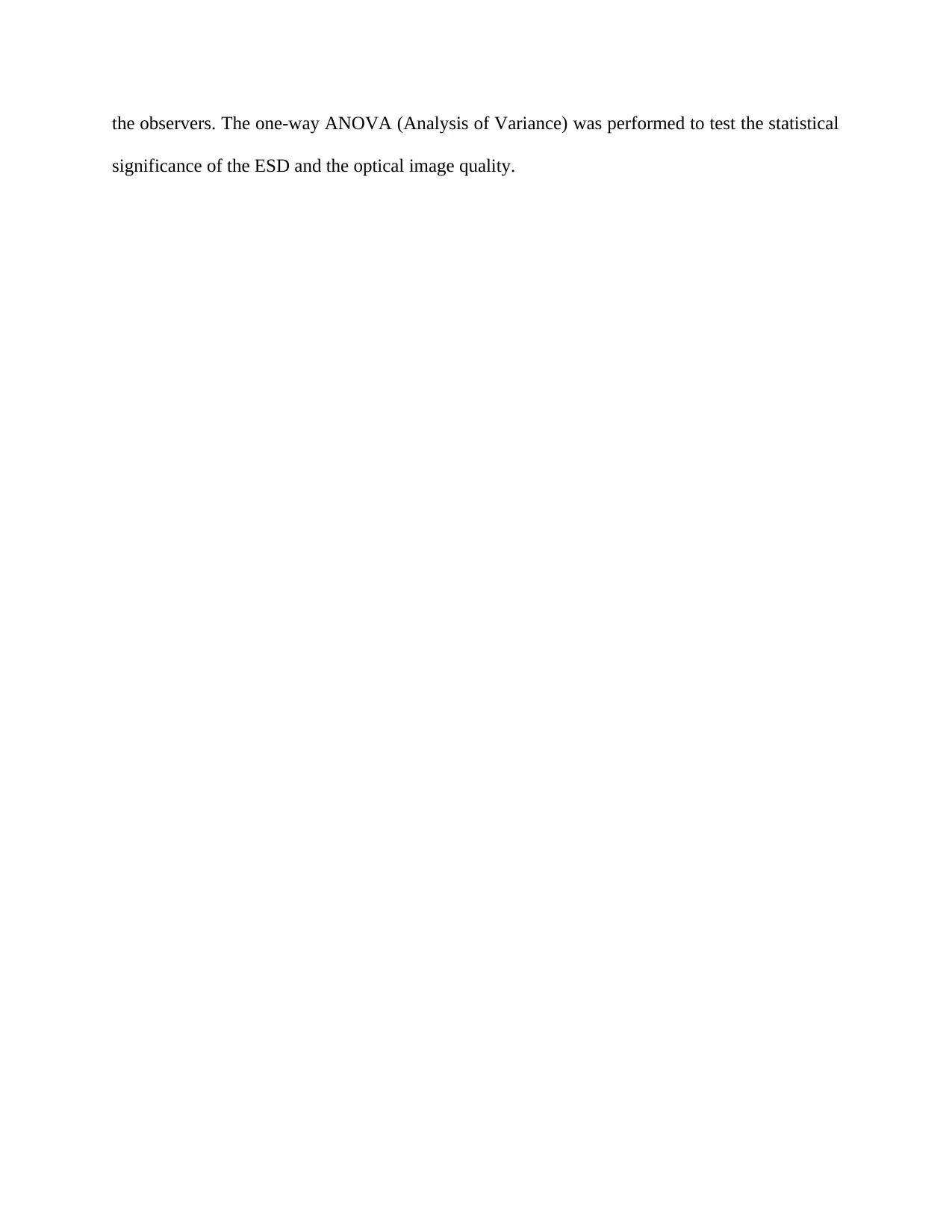
the observers. The one-way ANOVA (Analysis of Variance) was performed to test the statistical
significance of the ESD and the optical image quality.
significance of the ESD and the optical image quality.
1 out of 7
Your All-in-One AI-Powered Toolkit for Academic Success.
+13062052269
info@desklib.com
Available 24*7 on WhatsApp / Email
![[object Object]](/_next/static/media/star-bottom.7253800d.svg)
Unlock your academic potential
Copyright © 2020–2025 A2Z Services. All Rights Reserved. Developed and managed by ZUCOL.